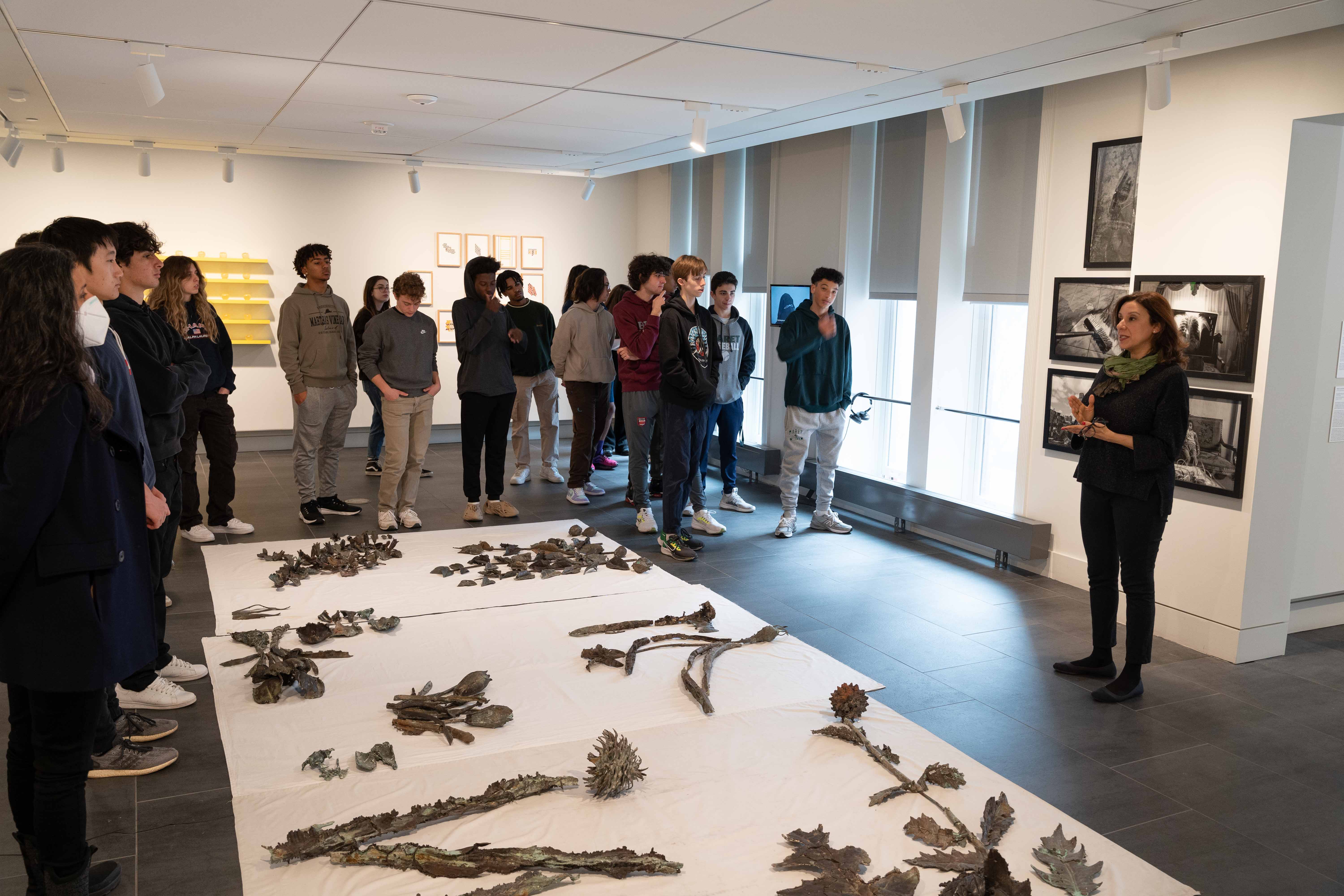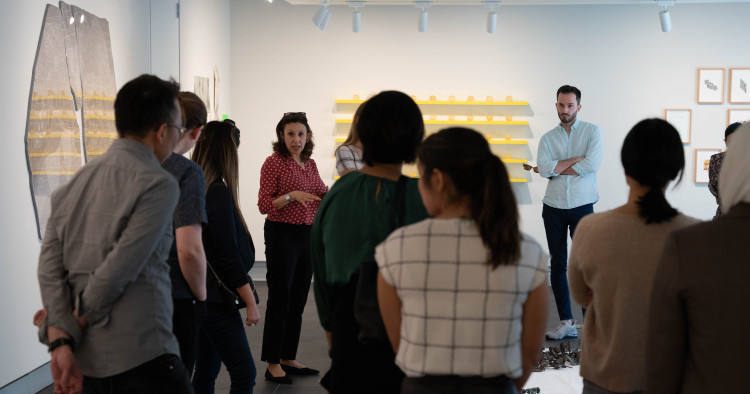Perceptible Rhythms/Alternative Temporalities runs until June 2, 2023. For more information, please see the MEI website. An art talk and tour of the exhibition will be held on April 20, 2023 from 6:00-7:00 pm.
In the Middle East, there is an entangled relationship between colonial legacies and the climate, though the causality is often misconstrued. In his 2015 book The Conflict Shoreline, the architect, activist, and theorist Eyal Weizman offers an alternative way to approach the climate crisis and its origins, writing that, “even the most militant environmentalists still regard climate change as the ‘collateral of history’ — the unintended byproduct of industrial development, trade, and transport; whereas I see it as the intention, the very telos, of the colonial project.”
Capitalist or colonial models serve an accelerated present of material excess and control. Systems of environmental mastery, economy, and industry are abstractions treated as fixed realities, often supported by the machinery of histories made monumental. However, in their shadow, subtler realities coexist. Talking to artists in the development of this exhibition, other temporalities and rhythms became louder than the unyielding forms imposed by borders, maps, or received histories. Without disregarding the violence done by projects that prioritize growth or extraction over people and environment, this exhibition chooses to tune into alternatives that are malleable and personal.

Landscapes change form, designations change landscapes
Deltas reroute and rivers rise or run dry. Land once fertile becomes barren. In this region, such shifts do not only tell the story of climate change. Nadia Bseiso trains her camera on the wreckage wrought by entangled colonial legacies and environmental change. Travelling the four contemporary borders of Jordan for Infertile Crescent (2015-19), her photographs document the aftermath of tumultuous geopolitical events that have broken the bond between people and land. The journey is meticulous and attentive; though it traces man-made borders, she reads nature’s indicators, such as water resources, to witness history and divine futures. Abbas Akhavan’s Study for a Monument (2014) also refigures the history of “the cradle of civilization” via attunement to nature. He casts subtle ecological archives in bronze, a material more often used to fix history through monuments to significant figures or the memorialization of war. The work hints at the way narratives of a place can organize lived reality just as much as maps, giving emphasis to facets of the past that condition futures.
The fate of the river is the fate of a place. Marianne Fahmy’s Disappearing Land (2022) explores cartographic flux, telling the story of Egypt’s relationship to the mighty Nile River. The changing currents of the Nile condition both geographic and cultural realities. Maps designate landscapes and designations change our relationship to place — but it only gives an impression of stasis. The will of the river, the delta, the landscape overrides the temporary statecraft of borders and populations. Filwa Nazer’s In the Fold (2019) is also interested in mutability, drawing parallels between mimicry and camouflage in the insect world and the way human beings adapt socially, assimilating to different groups for good or ill.
Contrary to this mutability, Abdulnasser Gharem’s Climate Refugee (2022) is vigilant to the repetitiveness of administrative or geographic authority. A map of the world is rendered in rubber stamps, suggesting the bureaucracy faced by migrants with actions that override human presence. Gharem lays bare the way perpetual repetition — of laws, maps, or artificial cultural differences — exerts control over the subconscious, enforcing bureaucratic violence that is designed to tame. As these rules and histories are repeated in the daily work of law and order, they uphold extractivist models that alienate people from the environment. Finding and developing narratives to work against received modes is thus paramount. Though stories told cannot halt the violence of industry or statecraft, awareness of them may help to make a change by degrees.

The land and its stories are in flux, but so are we
Where Gharem sees the damage that repetition does to autonomy, Maha Nasrallah prizes it as a means to hold on to her culture and homeland. Finding herself far away from home, Bounce (2022) is her attempt to stitch a connection to a place lost from her, as she embroiders memories and feelings into washing sheets. These are simple household materials that would ordinarily be used and discarded, but the stitches are insistent and persistent. Here, the implied tumble of a machine cycle has more to do with an incantation of chosen thought than it does with any kind of enforced cultural repetition. Nasrallah is interested in whether and how the flotsam of culture constructs identity and connection to place, not the other way around, asking of the music of Fairouz “did we build our culture around her folk songs?” If a half-remembered song can assert a hold over self and diasporic identities, the collection and preservation of personal archives is a means to work against alienation.
These received narratives can work in two directions, emanating from the individual and community, or imposed from above. Christian Sleiman’s Untitled (stories around trees) (2022) exists in between. He surveys trees in urban spaces of Beirut, weaving stories around the migration, importation, and extinction of different family trees in Lebanon. Here, the trees function in cultural and collective consciousness as well as playing roles in complex ecologies. Similarly, Moza Almatrooshi’s practice looks at the ways narratives from ancient and contemporary mythologies of the Arabian Peninsula uphold nation-building techniques. In The Agriculture School: The Honey Forager's (Maktoom Alshehhi) Landscape in Jebel Yanas (2022), she finds nation-building to be intertwined with food cultures, approaching it from two perspectives. The first is the thematic focus of the series that the work comes from, that of a British agricultural intervention from 1955. This specific work focuses on the insight of local farmers from the country. One perspective is removed, from above, exerting a misplaced authority; the other is intimate, personal, and evolved through patient attention and connection to the land.
Sarah Abu Abdallah also looks to plant existences, drawing on the potency of seeds as a way to understand how culture, identity, and nature overlap. Where Akhavan’s ecological archives speak to regional histories, here the engagement is more personal. Seed movements intimate the dynamics of the histories that form us. Sarah Abu Abdallah, like Nasrallah, is interested in what of our “home” can be carried with us. Though here the loss is not threatened by migration, but by urbanization. The resin tomato forms of Fortitude (2020) contain heirloom seeds from her town of Qatif, Saudi Arabia. Grown by generations of farmers, the plant has become virtually extinct due to the rampant industrial development of the region.

Where these artists consider the subtle drift of seeds and ecologies across territories to intuit social patterns, Mohamed Mahdy’s Moon Dust (2020) is a film and series of photographs that reckon with a different kind of sediment. He documents the fate of Wadi al-Qamar (“moon valley” in Arabic), a settlement in west Alexandria. Remembered by older generations as a place of recreation and healing, today its 60,000 residents live under a constant cloud of toxic dust emitted by a cement plant. The misbalanced relationship between people and industry shows how life can be altered drastically in a very short period of time through the incursion of unregulated environmental pollution. Ali Kazim is attuned to the more epic temporality of artefacts found in the Indus Valley. The watercolors of Untitled (Ratti Tibbi) (2017-19) show fragments of terracotta belonging to a civilization that populated the Indus Valley from 3000 to 1500 BCE. The remnants become clues to the past, appealing to the human tendency for apophenia — recognizing and reading patterns. What do these fragments tell us about past civilizations and, by extension, our present and future?
For good and for bad, borders, stories, and cultures are repetitions, but so is the unseeing rendered by routines that numb. Though not explicitly concerned with any one form of environment or nature, Sarah Almehairi's work casts the incidental and unnoticed in the hustle and bustle of daily life into moments for attention. The collection of colors, shapes, incidences of light, and textures of materiality that make up Adjustments of the Daily (2022) invest what is most immediate, but most often overlooked, with new significance.
Composing this bricolage of most frequented places is to identify with the environment. Each of the works in this exhibition strives to enliven such connections by looking anew and afresh. Whether considering the lives lived in the temporal or spatial shadows cast by unrest, migration, and industry, or taking a long view of history or an attentive approach to an immediate setting, new relations are found. Attuned to different temporalities, rhythms, and frequencies — that of the tree, the day’s changing light, or the river’s altered course — allegiances to non-human agents and cultural histories are strengthened. Recollections of seas, songs, and trees compose mythologies that create relationships with places worth fighting for.
Maya El Khalil is an independent curator, based in Oxford, UK, who has worked extensively in Saudi Arabia and the Gulf with artists, collectors, and institutions to develop the identity and ideas that have defined a growing art scene. Her last exhibition, Portrait of a Nation II: Beyond Narratives, which she curated for the Abu Dhabi Music & Arts Foundation in 2022, celebrated 50 years of art in the UAE, showcasing over 100 artworks of more than 60 pivotal artists.
Photos by MEI staff
The Middle East Institute (MEI) is an independent, non-partisan, non-for-profit, educational organization. It does not engage in advocacy and its scholars’ opinions are their own. MEI welcomes financial donations, but retains sole editorial control over its work and its publications reflect only the authors’ views. For a listing of MEI donors, please click here.













